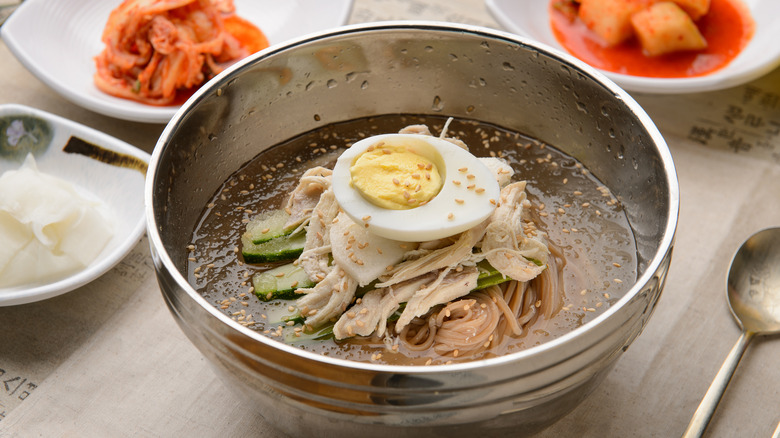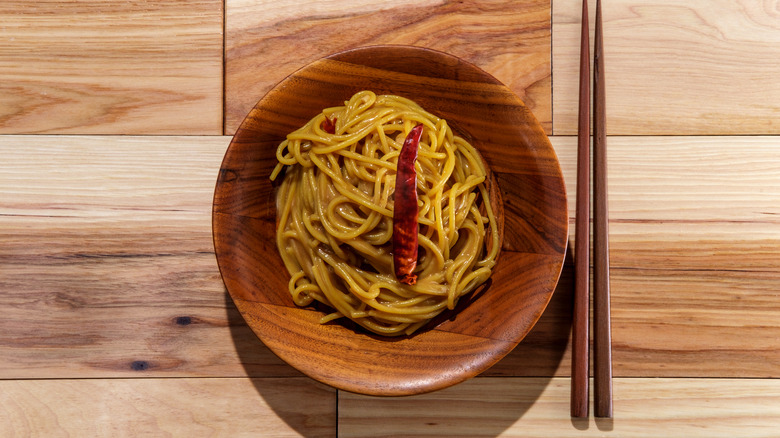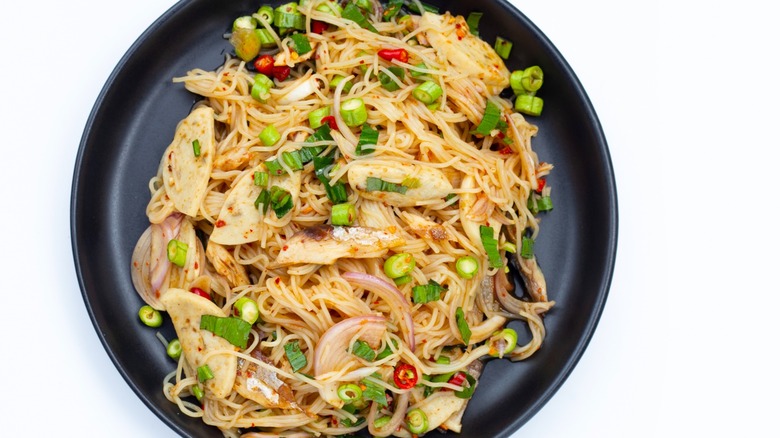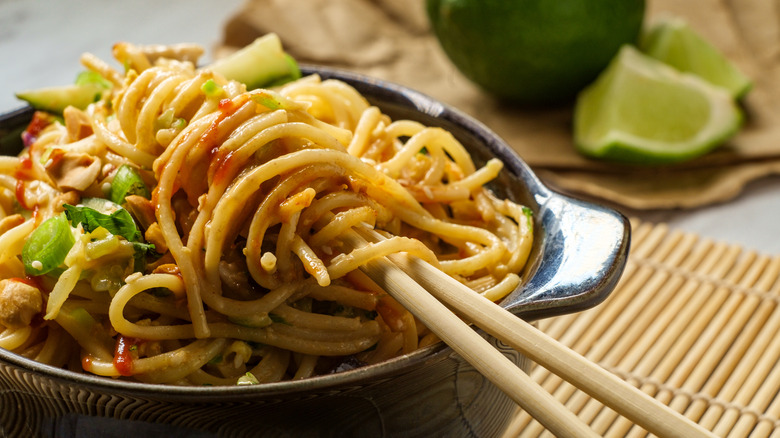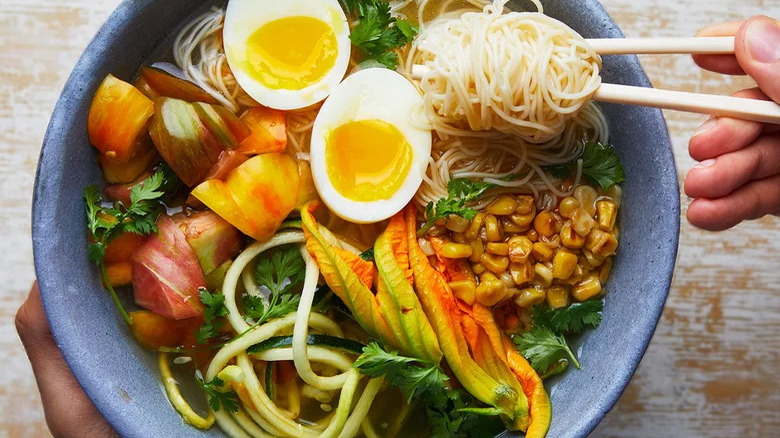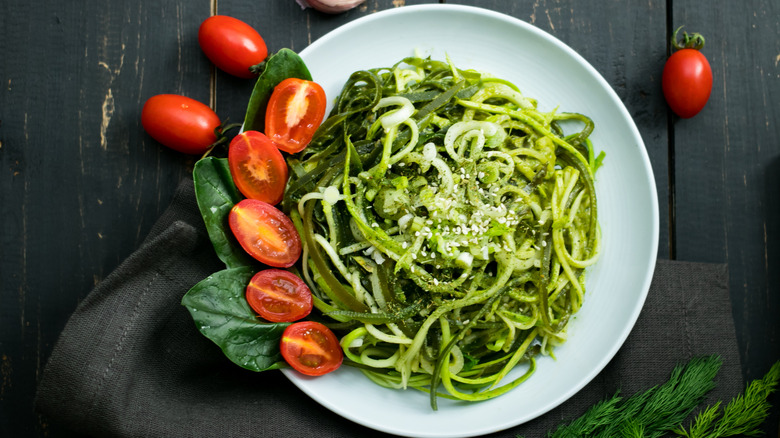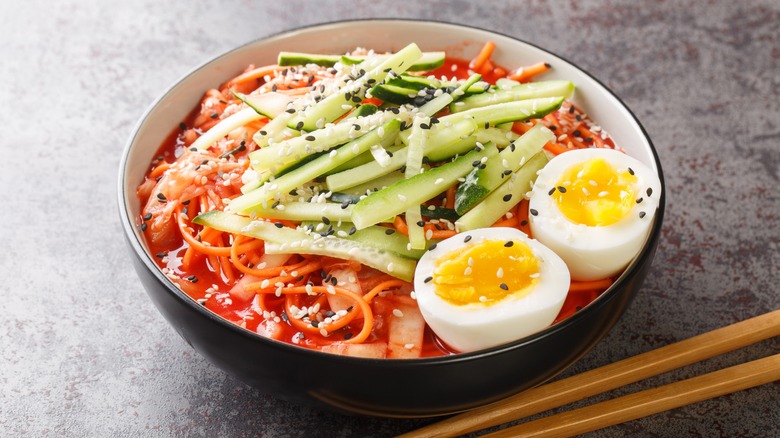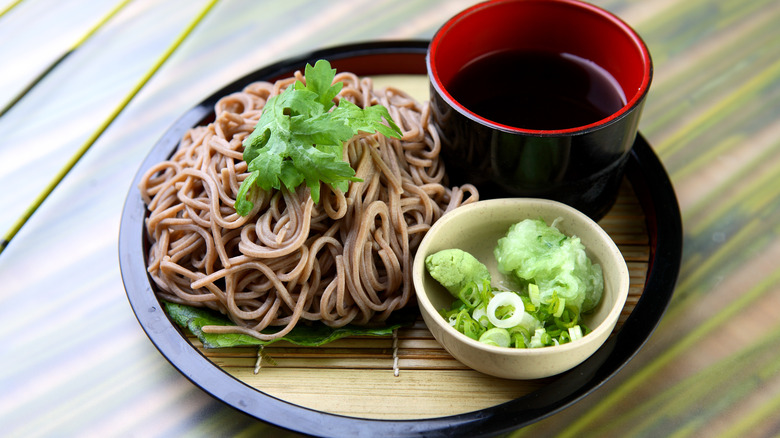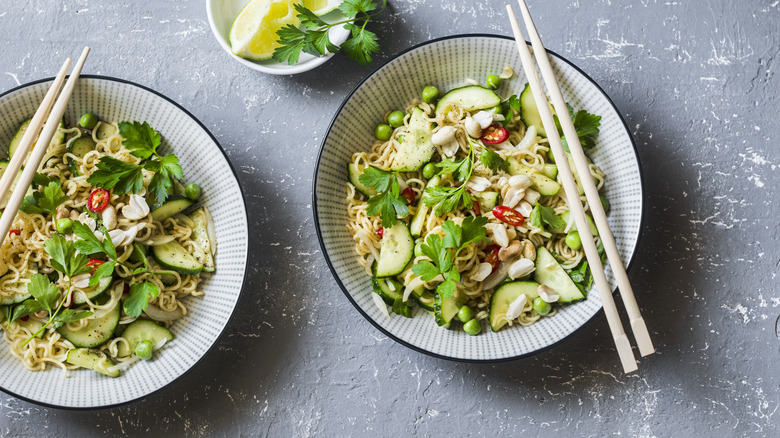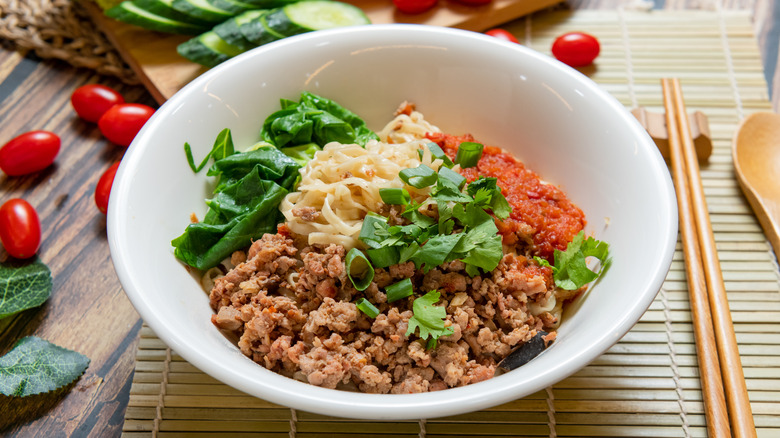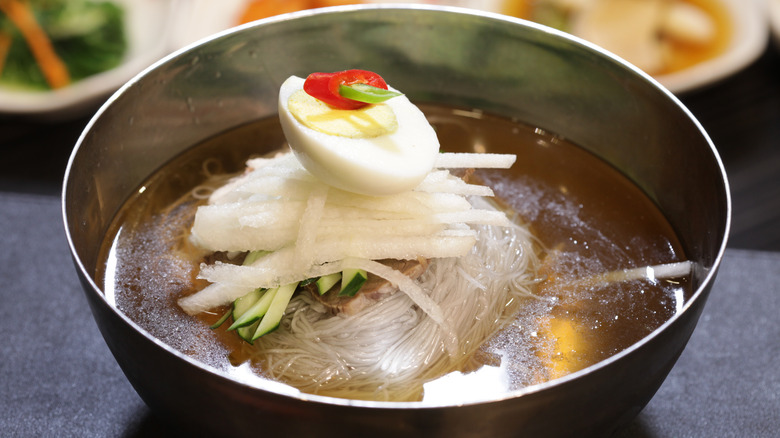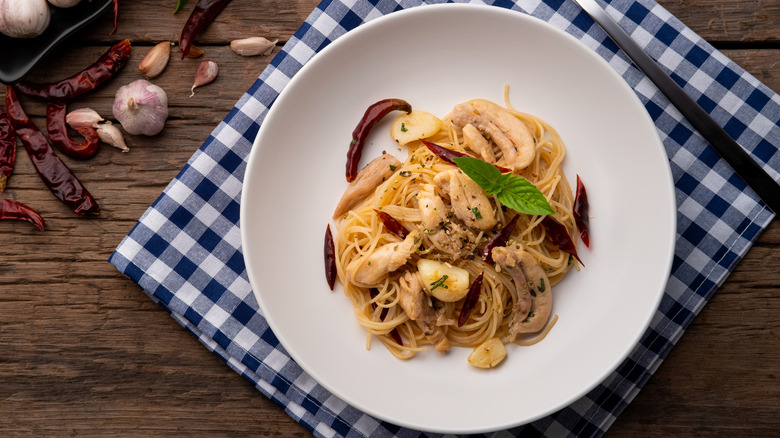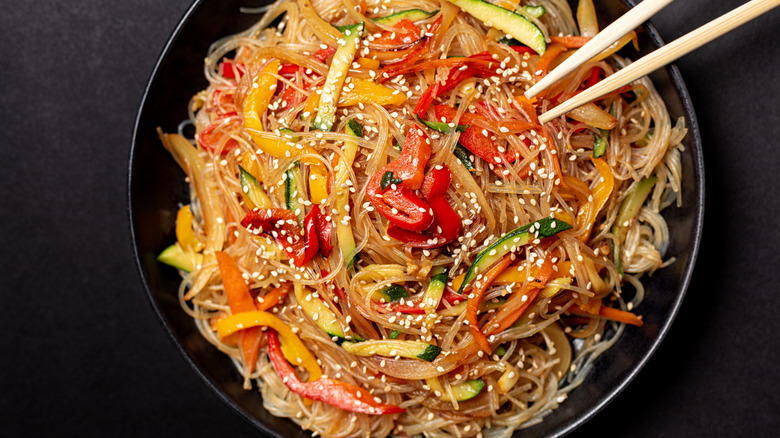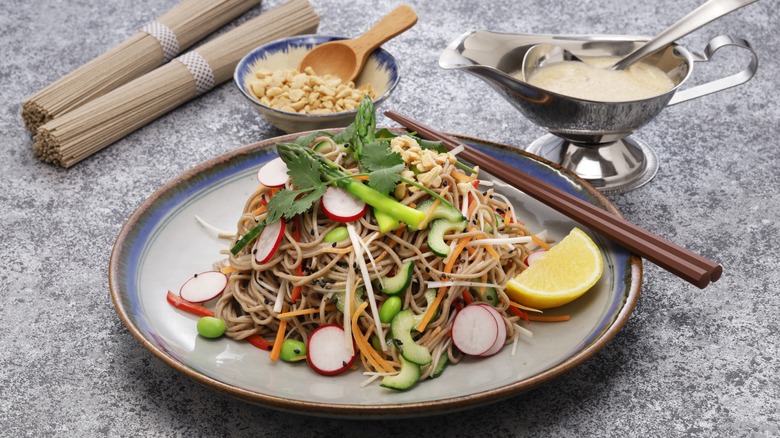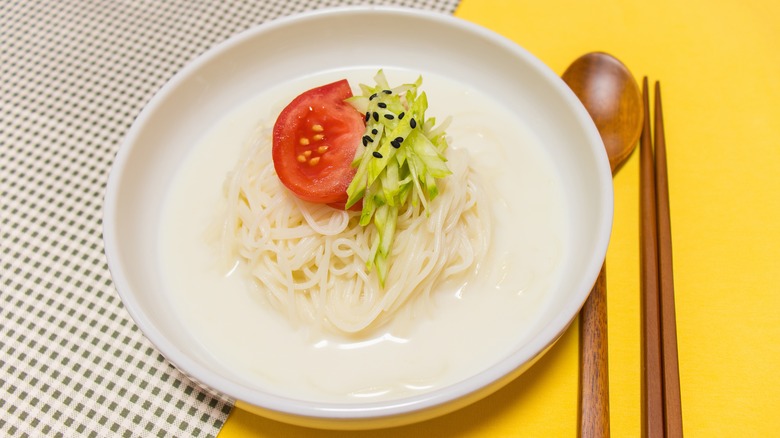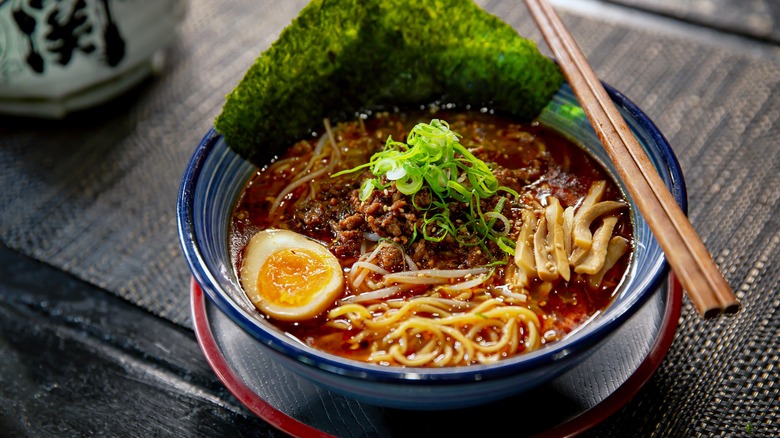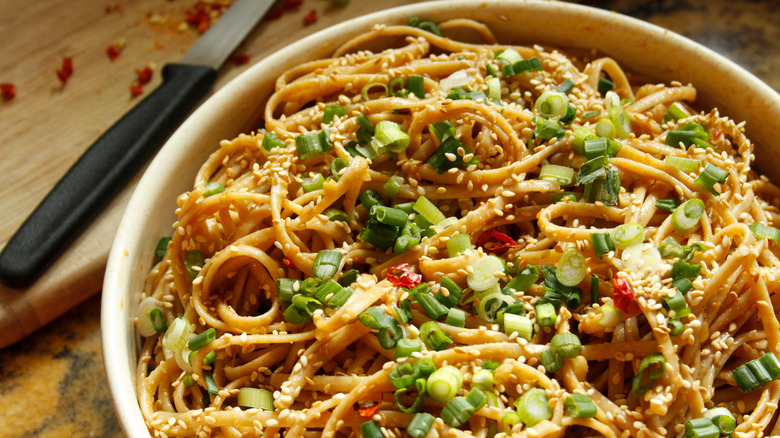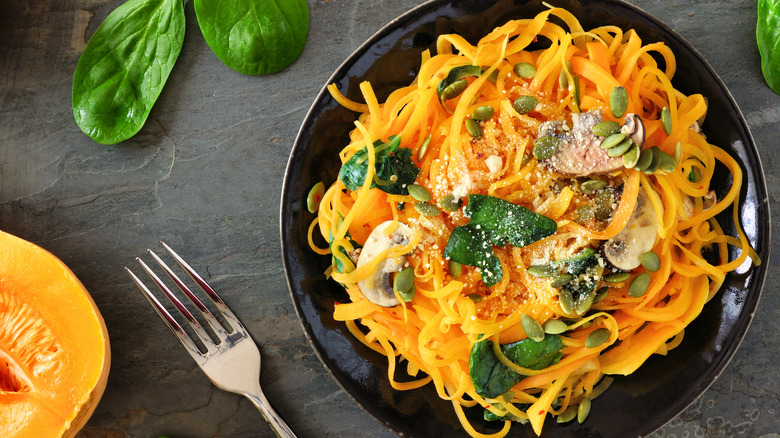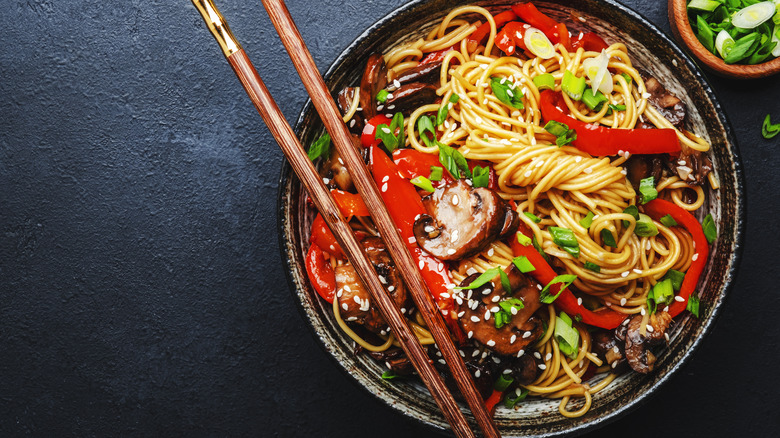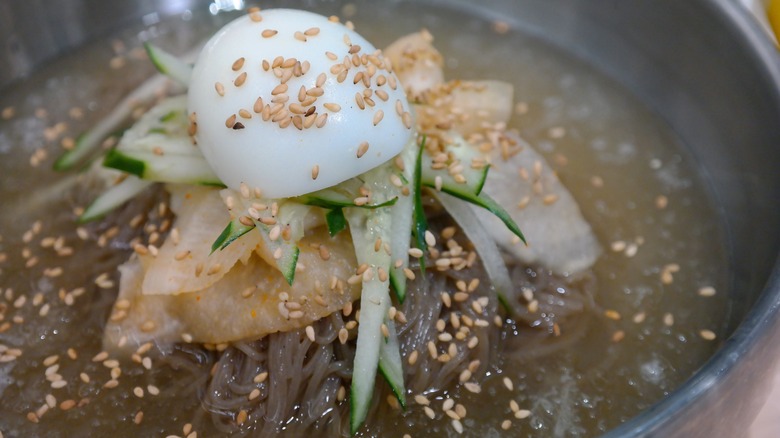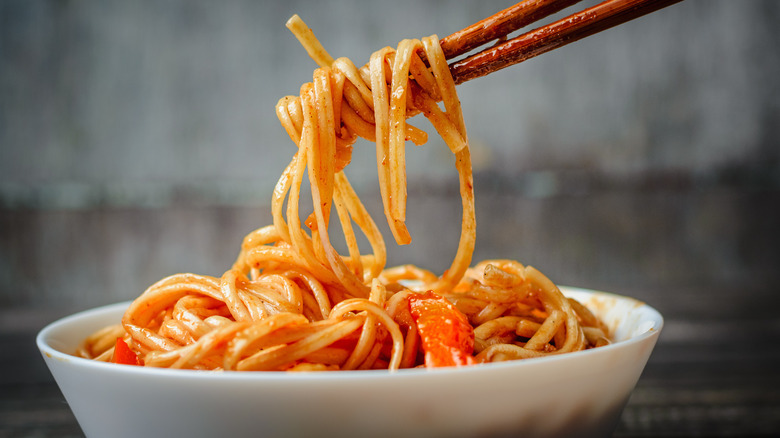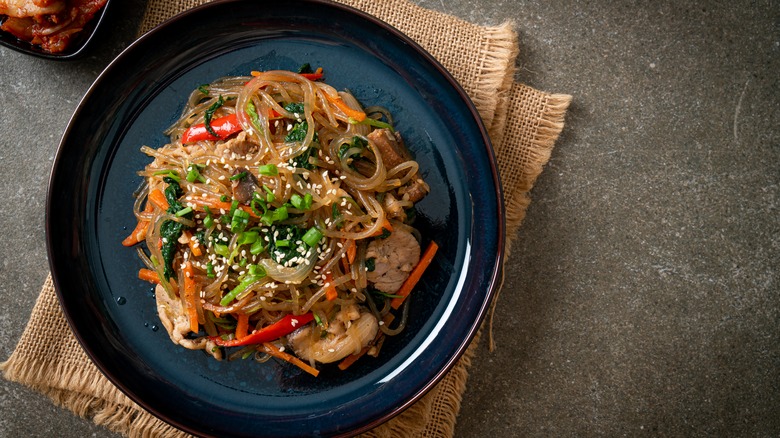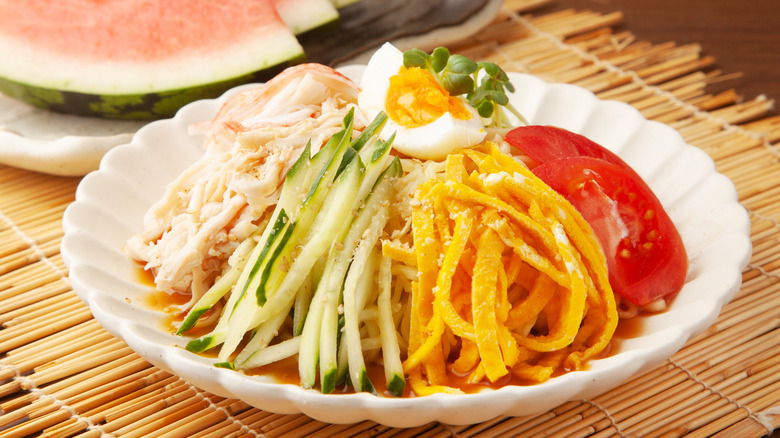22 Ways To Eat Cold Noodles For Summer
When the summer sun beats down, and you can barely muster the energy to cook, turn to a refreshing bowl of cold noodles to satisfy your craving. These chilled dishes can offer a respite from the heat when you're hungry but can't stomach anything too rich — and they will tantalize your tastebuds with a symphony of flavors and textures. Whether you're looking for a quick go-to lunch you can pull out of the fridge at work, a refreshing salad to snack on, or a comforting bowl to fulfill your cravings, these cold noodle dishes will keep you cool and refreshed. They will also allow you to explore exciting blends of summer flavors!
Feel free to customize the recipes to your liking, too. Perhaps you prefer chewy udon as opposed to slurp-worthy ramen and delicate rice noodles. Elevate the noodles as you please, with an array of vibrant vegetables, tangy dressings, and aromatic spices. From creamy peanut noodles to zesty vegan salads, savory Korean delights, and so much more, here are 22 ways to enjoy cold noodles this summer season.
Classic peanut noodles
There's nothing quite as satisfying as a bowl of cold peanut noodles. This super simple dish combines the perfect blend of flavors, textures, and aromas, making it an instant crowd-pleaser.
For the easiest peanut noodle dish ever, all you need to do is cook your favorite noodles until they're al dente. Then, mix them in with a dollop of creamy peanut butter, and voila! They're ready to go. You can even transform an almost empty peanut butter jar into the perfect noodle pairing to stretch your dollars and reduce waste — it's a win-win!
But, for some extra zest and flavor, combine the likes of ginger, soy sauce, lime juice, garlic, or fish sauce with your noodles and peanut butter. Toss sliced bell peppers, julienned carrots, crunchy bean sprouts, and thinly chopped scallions for a dose of vibrancy while providing a satisfying crunch with every bite. Enjoy cool as a tasty lunch or a light dinner.
Spicy vegan dragon noodle salad
This zingy, meat-free spicy vegan dragon noodle salad combines the coolness of crisp salad greens, the satisfying chewiness of pad Thai rice noodles, and the fresh crunch of cucumbers and radishes for an easy summer dish. To create the dressing, blend smooth, natural peanut butter, garlic, water, rice vinegar, soy sauce (or tamari), agave nectar, Sriracha, toasted sesame oil, and a pinch of salt until it reaches a silky-smooth consistency. This dressing is the perfect marriage of creamy, tangy, and slightly spicy flavors that will elevate your salad to new heights.
Next, cook the pad Thai rice noodles, ensuring they're nice and tender, but not overdone. Refresh them under cold water to help them maintain their ideal texture. Toss the noodles with the dressing, along with the cucumber and radish slices, ensuring that every strand is coated in the mouthwatering flavors of the dressing.
For the finishing touch, add a handful of toasted or black sesame seeds for a delightful crunch and garnish with fresh cilantro (if you're a fan, of course) to infuse the dish with its unmistakable aroma. For the organized among us, you can prepare this salad in advance and keep it refrigerated for up to five days for a ready-to-go lunch or dinner.
Chilled sesame noodles with vegetables
These chewy and tender chilled sesame noodles are easy to make and similar to classic peanut noodles. However, this variation on the classic has a more specific ingredient pairing.
Picture these egg noodles chilled to perfection, thrown together with fresh, thirst-quenching cucumbers, and accompanied by a light coating of peanut butter. The nutty richness of the peanut butter combines harmoniously with the gentle flavors of sesame oil and soy sauce, while sesame seeds add a much-appreciated crunch.
For a more substantial meal, consider adding protein options such as grilled chicken, shrimp, or tofu. Marinate your choice of protein in a soy-based sauce with hints of ginger and garlic to complement the flavors of the noodles.
One of the joys of chilled sesame noodles is their versatility. Whether you're seeking a quick lunch you can grab from the refrigerator or a crowd-pleasing dinner for the whole family, they effortlessly fit the bill. Even those picky eaters who have a fondness for peanut butter will find themselves devouring these noodles with glee.
Cold summer ramen bowl
As summer lingers and you yearn for the hearty comforts of fall, a Cold Summer Ramen Bowl combines the best of both worlds. Prepare to be captivated by the colorful array of summer produce, including heirloom tomatoes, sautéed corn, and spiralized summer squash, all swimming in a chilled dashi stock infused with corncobs and miso. The freshness of the dish offers a revitalizing twist on the thicker, more substantial soups that will warm your soul during the colder months.
With each spoonful, savor the refreshing interplay of flavors and textures. The coolness of the broth complements the juiciness of the vegetables and the chew of the noodles. The combination of tender corn, juicy tomatoes, and delicate squash adds a burst of summer essence to every bite.
Alternatively, mix in some diced mango for a dose of tropical sweetness or grilled or chilled tofu for a protein boost — the possibilities are seemingly endless. With this cold ramen, embrace the magic of late summer and treat yourself to a bowlful of bliss.
Cold zucchini noodles
Indulge in the cool and refreshing delights of cold zucchini noodles this summer — a dish that showcases the incredible versatility of this nutritious vegetable. With the help of a spiralizer, zucchini transforms into the perfect pasta alternative, offering a lighter and healthier option for your favorite noodle dishes. When selecting zucchini for your zoodles, opt for smaller ones as they have fewer seeds and are less watery, ensuring a better texture.
Prepare the zucchini for the spiralizer by removing the thick stem and making a vertical cut halfway into each one, allowing for more manageable noodle lengths. Secure the zucchini in the spiralizer and use the spaghetti blade to create beautiful, round zoodles.
Shake a little salt on the zoodles and let sit for about 10 minutes in a colander, allowing any excess moisture to drain away. Afterward, cook the zoodles for 2 minutes in a frying pan with a touch of rich olive oil and the remaining salt.
Once cooking is complete, press the zoodles against the colander to remove any remaining water. Gently pat the zoodles dry with a paper or tea towel before transferring them to a serving bowl. Top the zoodles with your preferred sauce, opting for a thick and flavorful option, like tomato, that complements the zucchini.
Korean bibim guksu
Bibim guksu, which translates to "mixed noodles," is a Korean dish that effortlessly captures the essence of summer. It starts with perfectly cooked somyeon noodles, which are thin and delicate, providing a satisfying chewiness. These noodles are then tossed with bright, colorful vegetables that add a burst of freshness. Crisp cucumber slices, juicy cherry tomatoes, and sharp pickled radishes unite in a tantalizing harmony.
But, what makes bibim guksu special is the sauce. It's a masterpiece of flavors, combining spicy, savory, and tangy elements.
Gochujang, a fermented Korean red chili paste, delivers a kick of heat that lingers on your tongue. Soy sauce adds a savory depth, while sesame oil brings a rich nuttiness. Vinegar and sugar balance out the flavors, creating a harmonious blend that dances on your palate.
A boiled egg, sliced in half, is placed on top of the heap of noodles, its golden yolk oozing into the mass for a gooey, creamy finish. And, a sprinkling of sesame seeds adds a little crunch and an earthy aroma.
Cold Korean buckwheat noodles
Cold Korean buckwheat noodles masterfully combine an assortment of textures and flavors for a fresh summer dish. Start with the core ingredient: dried buckwheat noodles. Boiled until just tender, they provide a pleasingly chewy base that absorbs every flavor while maintaining their nutty essence.
Next, there's a vibrant sauce blending rice vinegar, gochujang (a spicy, savory Korean red pepper paste), a touch of fiery gochugaru chilli powder or hot paprika for a bit more heat, a sprinkle of sugar, and a dash of salt. This intricate fusion reveals a beautifully balanced sweet, spicy, tangy, and salty profile that's hard to resist.
This dish isn't just about the noodles and the sauce, though. Added to the mix are crunchy pieces of daikon (the Korean radish) tossed in the sauce to absorb its robust flavors. Alongside there are crisp slices of English cucumber. And then, a concoction of toasted sesame oil, garlic, and finely chopped scallions add aromatic dimensions to the bowl.
But, we're not done. The final garnishes include a generous sprinkle of toasted sesame seeds for a dose of crunch and shredded toasted kim, a type of seaweed. Last but not least, a cup of chicken stock is poured around the noodle mound for you to enjoy every slurpy bite.
Vegan cold cucumber chili noodles
Cold cucumber chili noodles give East Asian cuisine a minimalist approach by paying tribute to the power of clean, uncomplicated ingredients. The heart of the dish lies in its base of thick flat rice noodles. When cooked al dente, these dense noodles offer a chewy texture. As they cool, the noodles transform into a base waiting to be dressed up.
The juicy English cucumbers, whether cut into thin slices or beautiful ribbons with a vegetable peeler, provide a cool contrast to the substantial noodles. The green onions, thinly sliced, deliver a gentle heat and pungent sweetness that balances the freshness of the cucumber.
However, the real magic begins when you drizzle toasted sesame oil over the noodle mixture. This oil, with its deep, nutty, and aromatic taste, infuses the dish with a rich depth that anchors the refreshing elements.
Then the sesame seeds' toasted crunch adds extra contrast to the noodles and cucumbers while echoing the flavors of the sesame oil. And, of course, for those who appreciate a bit of heat, a generous splash of chile oil adds an unexpected spark of spice that warms the palate.
The beauty of this summer dish lies not just in its flavor, but also its versatility. You can adjust the amount of chile oil for your preferred heat level, and the garnishing can be customized to your exact liking. Welcome to vegan comfort food at its finest.
Yunnan-style cold noodles
Introducing Yunnan-style cold noodles – a creation by Travis Post, formerly executive chef at New York City's Yunnan Kitchen. Drawing inspiration from his explorative culinary journey in China, this dish beautifully unites contrasting elements.
Start with a base of chilled Thai or Vietnamese rice noodles. Whether round or flat, the noodles impart a fulfilling chew that will have you reaching for your chopsticks again and again.
Now, the core of this dish: the seasoned pork. The high-heat wok blend of ground pork, fragrant garlic, spicy fresh ginger, caramelized light brown sugar, and rich soy sauce results in a concoction that bursts with flavor. This meaty addition provides a warming distinction to the coolness of the noodles.
Then, a spiced soy dressing (a blend of regular and dark soy sauces), tangy Chinkiang or black vinegar, brown sugar, a hint of spicy Sichuan peppercorns, and an undertone of star anise or Chinese Five-Spice Powder — coats the noodles and pork so every bite is steeped in flavor.
The noodles and seasoned pork come together with thin English cucumber slices, aromatic mint, and love-it-or-hate-it cilantro. And, a final sprinkle of chopped roasted peanuts lends a welcome crunch and an added layer of nutty flavor. And, for those who fancy a rise in temperature, a trickle of chile-garlic oil adds the perfect spicy kick.
Mul naengmyeon Korean noodle soup
Originating from North Korea, mul naengmyeon translates to "cold noodles," and it certainly lives up to its name. This dish features intensely elastic buckwheat noodles bathed in an icy beef broth. A Korean summer classic, this cold noodle soup will rejuvenate you with its sweet, vinegary flavor profile.
Creating mul naengmyeon is an art in itself. The buckwheat noodles possess a signature elasticity that calls for meticulous preparation. And the broth, typically a combination of beef, chicken, and pork, usually requires hours and even days to create. The result is a sweet and sharp flavor, enhanced by adding radish kimchi brine or dongchimi (another type of kimchi).
Mul naengmyeon can be found in Korean barbecue restaurants, often served alongside sizzling, fatty meats for an interesting hot-cold dining experience. If you want to try your hand at the dish at home, you can find everything you need at Korean markets like H Mart, including the special buckwheat noodles and frozen mul naengmyeon packs. However, don't let that stop you from creating your own broth.
Capellini pasta noodles
Capellini pasta noodles are a delicate Italian masterpiece loved for their fineness, comparable to a third of the size of spaghetti. Crafted from a simple mix of flour, eggs, and water, this pasta mirrors the elegance of its name, which translates to "little hairs."
Typically sold as beautifully rolled nests, these pasta noodles require just a brief dosing in boiling water. They're then ideally combined with light, minimalistic sauces that complement their fine texture.
Capellini is often infamous for its tendency to overcook, transforming into a somewhat mushy and tasteless form. Yet, capellini is cherished for its easy digestibility, requiring little chewing, making it a favored choice in broths for infants and new mothers in Italy.
The magic of capellini comes alive when partnered with fresh flavors and light dressings. Try the pasta enrobed in gentle, aromatic dressings of ripe tomatoes, fragrant herbs, garlic, a trickle of oil, or a kiss of butter and cheese. And, during the hot summer months, try capellini served cold in salads. It can also be introduced to cool stir-fries paired with thin slices of meat, resulting in a quick and balanced meal.
Japchae Korean stir-fry noodles
Japchae is an exquisitely flavorful Korean dish that elegantly weaves together noodles, meat, and a colorful palette of vegetables. While loved as a culinary symbol of celebrations and special gatherings, this cold stir-fry isn't restricted to festive times.
Japchae is savored all year round and often represents a seamless introduction to the diverse world of Korean cuisine for non-Koreans. The name japchae means "mixed vegetables," reflecting the selection of vegetables that accentuate this dish.
The star ingredient, springy glass noodles, or dangmyeon, forms the backbone of Japchae. These noodles intertwine with a lively mix of vegetables, including carrots, spinach, mushrooms, onions, scallions, and more. Meat, typically thin slices of beef or pork, adds a hearty dimension to this dish, while a garnish of sesame seeds and sesame oil completes the ensemble.
Though typically served as a side dish, Japchae works well as an appetizer or a potluck favorite at summer garden parties or barbeques. It can be served hot and cold, making it a versatile dish to enjoy whatever the weather.
Japchae can be reinvented in various forms. Try your hand at a vegetarian rendition featuring soybean sprouts, a seafood-infused spicy option, or a vegan variant substituting meat with tofu or additional mushrooms.
Cold soba noodle salad with shrimp, mango, and tomato
This cold soba noodle salad comes from culinary director Paul C. Reilly of the Beast + Bottle Group in Denver. A refreshing respite from the summer heat, this dish is an artful assembly of cold soba noodles, grilled shrimp, creamy tahini, succulent mango, and ripe tomato.
Start with a zesty marinade that blends the nutty richness of tahini with the savory depth of soy sauce, the warmth of ginger, and a hint of heat from the Sriracha, resulting in a concoction that infuses the shrimp. Charred on a grill, the shrimp, saturated with flavors from the marinade, delivers a smoky taste that contrasts the fresh, cool elements of the dish. The ripe mango and plum tomatoes, grilled until slightly charred, add a sweet and tangy symphony, emphasizing the flavors further.
The hero of the dish, the soba noodles, are boiled until al dente and then cooled, forming the base of the salad. Tossed in the reserved marinade, the noodles become a union of flavors and textures, enveloped by the soft tahini, invigorating ginger, and fiery Sriracha. Finally, the noodles involve the addition of grilled shrimp, chopped mango, and tomato, enhanced by the crunch of thinly sliced scallions, aromatic basil, and toasted sesame seeds.
Cold Korean kongguksu soy milk noodle soup
Kongguksu, which translates to "bean noodle soup," is a blend of a cold, rich, and creamy soymilk broth cradling a bed of thin wheat noodles. Its silky soymilk broth, coupled with al dente noodles, creates a soothing, refreshing dining experience. Garnish with additional ingredients or savor its pure, minimalist charm.
The creation of kongguksu starts with homemade soy milk, crafted by soaking, cooking, and puréeing dried soybeans. Adding pine nuts and sesame seeds delivers an earthy flavor to the creamy broth and the somyeon or somen (thin wheat noodles) nestle within this chilled soymilk broth.
But, while kongguksu traditionally focuses on the pure flavors of soymilk and wheat noodles, there are many ingredients you can introduce to complement or contrast its taste and texture. For example, small cubes or balls of honeydew or cantaloupe can add a refreshing sweetness, while sprinkling chia or hemp seeds on top of the noodles can enhance the dish's nutritional value and deliver a slight crunch.
Sichuan-style liang mian cold noodle salad
For a refreshing and light vegetarian meal that's full of flavor, you might try Sichuan-style liang mian cold noodle salad. This dish, originating from the book "Wok On" by Ching He Huang, puts forward a delicious cold egg noodle salad where the dressing takes center stage. The Sichuan pepper, chili, garlic, and ginger mingle wonderfully with the slipperiness of the egg noodles.
To bring this cold noodle salad to life, start by cooking the noodles per the instructions on the packet. Post-draining, refresh the noodles under cold running water, drain them well, and toss them with toasted sesame oil.
Next, swirl rapeseed oil in a hot wok, toss in the garlic, ginger, and chili, stirring for a few seconds. Then, mix in chili bean paste, rice wine or dry sherry, sesame paste or tahini, vegetable stock, tamari or light soy sauce, vinegar, sugar, and a duet of sesame and chili oils. Combined well, the hot mixture bathes the noodles in an intense flavor. After a brief chill in the fridge, garnish with blanched beansprouts for an extra crunch. A sprinkle of Sichuan pepper, spring onions, toasted sesame seeds, and coriander completes this taste explosion.
Meat lovers, consider adding shredded chicken or thinly sliced beef. Shredded chicken subtly complements the dish's spicy notes, while thinly sliced beef, briefly stir-fried with garlic and ginger, introduces a savory depth. Whichever protein you choose, ensure its flavors combine well with the aromatic Sichuan dressing without overshadowing it.
Green chili cold vegan noodles
Chef Danny Bowien, a Korean-American adoptee from Oklahoma, brings to the table an electrifying, vegan-friendly dish: green chili cold noodles. This creation is inspired by his own journey of self-discovery, Korean heritage, and a deep desire to make people happy through food.
The dish perfectly represents simplicity with complexity, a fascinating interplay of the senses: heat from the chili and cold from the noodles. The green chili paste, a staple in Bowien's kitchen, is a multi-layered concoction of poblano chilies, serrano, or small jalapeño chilies, rice vinegar, and mushroom seasoning powder. This roasted green chili paste is the soul of the dish, adding a vibrant zing to the homemade semolina noodles or fresh Japanese ramen. These cold noodles are prepared with a touch of Sichuan peppercorn powder, mixed herbs, and olive oil and finished with a sprinkle of lemon zest.
For an even lighter and healthier version, replace the homemade semolina noodles or Japanese ramen with spiralized zucchini or rice vermicelli. The roasted green chili paste remains the star of the show, lending its invigorating flavor to every bite. Topped with freshly chopped cilantro and a squeeze of lime, this twist offers a refreshing fusion of textures and tastes that are perfect for those scorching summer days.
Chilled summer squash and sesame noodles
Welcome to this healthy take on traditional sesame noodles: chilled summer squash and sesame noodles. This clever spin on sesame noodles offers a cooling respite that satisfies the palate while reducing the heat in your kitchen.
The main components of this dish — zucchini and yellow summer squash noodles — are gently blanched to soften their raw edge. The beating heart of the dish, however, is the velvety, spicy sesame sauce that enrobes these garden-fresh "noodles." This blend of tahini, fresh lemon juice, toasted sesame oil, rice vinegar, aromatic garlic, and fiery chile oil or cayenne pepper takes the humble squash to new culinary heights. Sprinkling toasted sesame seeds as a final garnish delivers an added layer of texture and a nutty flavor.
Despite its gourmet feel, this recipe is wonderfully versatile. The sauce and noodles can be prepared ahead of time and chilled in the fridge until ready to serve, making it an ideal choice for a sophisticated yet easygoing summer lunch or dinner in the heat.
Sichuan cold vegan noodles with homemade chili oil
Indulge in a whirlwind of flavors with these speedy Sichuan cold noodles with homemade chili oil. With a preparation time of less than 30 minutes, this recipe adds an exotic touch to midweek lunches or dinners without demanding too much of your time.
Packed with a variety of crunchy shredded vegetables, these cold noodles deliver not just on taste but also on texture. The recipe welcomes customization, too. Shredded chicken or beef can be added for a heartier meal, or you can throw in some fried tofu to elevate the protein content without introducing meat.
Thin wheat noodles are preferred, but dried wheat noodles can serve as an acceptable alternative. But, the soul of this recipe is the homemade chili oil. With its medley of Sichuan chili powder, Sichuan peppercorn powder, sesame seeds, star anise, ginger, and spring onion, the chili oil infuses a warm, earthy, and complex flavor to the dish.
To assemble this summer bowl, noodles are cooked to al dente, chilled, and then tossed with a sauce made from soy sauce, Chinkiang black vinegar, sugar, salt, and garlic. Shredded cucumber and carrot are added for an extra chomp, and chili oil is dribbled across the mixture according to one's spice preference. Finally, garnish with sesame seeds and spring onion rounds and relish in the authentic flavors of Sichuan cuisine in your own kitchen.
Korean chilled buckwheat noodle soup
This Korean chilled buckwheat noodle soup is brought to you by chefs Da Hae and Gareth West. Featured in their cookbook, "K-Food," this recipe stands out with its blend of traditional and fusion elements that make Korean cuisine so globally loved.
As a top favorite for summer indulgence, this soup shines with its springy and chewy naengmyeon buckwheat noodles. A deviation from the soft somyun vermicelli usually used in Korean soups, these buckwheat noodles provide an excitingly different texture. The secret to the distinct taste of this dish lies in the abundance of vinegar and mustard in the ice-cold broth, making for a satisfyingly tangy sensation.
The preparation for this delight involves a simple, two-step process of preparing the broth and the sauce. The broth, brimming with the wholesome flavors of beef stock, garlic, ginger, and scallion, is chilled for an ultimate refreshing experience. Simultaneously, the sauce, a spicy-sweet combination of Korean red chili powder, sugar, apple vinegar, garlic, and ginger, is set aside.
The assembly of the noodle dish mirrors the simplicity of its preparation. The chewy noodles are boiled and served chilled over ice cubes, accompanied by slices of Asian pear and succulent beefsteak. A generous pour of the chilled broth, followed by a topping of halved hard-boiled eggs and a hearty spoonful of the prepared sauce, completes the dish. Finally, serve with English mustard and apple vinegar on the side for even more added taste.
Shanghai-style sweet and sour chilled noodles
Indulge in the sweet, sour, and tangy burst of Shanghai-style chilled noodles. This seemingly simple dish has a surprisingly robust taste, ensuring it stands out as more than just another noodle dish. Sold across Shanghai, this popular cold noodle dish represents the very essence of authentic Shanghainese cuisine.
Light and delicious, this dish can easily be transformed into a hearty meal by adding peas, broad beans, or poached chicken and a generous helping of fresh herbs. Additionally, for spice enthusiasts, a dollop of doubanjiang (chili bean paste) can introduce a spicy buzz.
But, the highlight of this Shanghai delicacy is the noodle dressing. The blend of light soy sauce, Chinkiang vinegar, vegetable oil, sesame oil, Chinese roasted sesame paste, caster sugar, and chili bean sauce creates a dressing that combines the best of Chinese cuisine. This dressing wraps the noodles in an unforgettably savory, sweet, and sour experience.
The noodles are paired with refreshing ingredients like julienned telegraph cucumber, spring onions, and ginger. They're then tossed in the rich Shanghai noodle dressing and sprinkled with roasted sesame seeds. Enjoy these noodles as they are or with a cold lager and transport yourself to the bustling streets of Shanghai.
Cold noodles with tomato-peanut sauce, pork and peppers
Experience these cold noodles with tomato-peanut sauce, pork, and peppers, delivered with exotic tastes and textures that will take you to the lively streets of Chinatown with every bite.
Start by sautéing ground pork and peppers, creating a fusion of crispy and tender pieces. Add an Italian-style sausage to complement the overall flavor profile, and enjoy the sweet crunch of red peppers or the unexpected heat from small green Padron or Shishito peppers.
Choose your favorite noodles, such as chewy lo mein, satisfying udon, or classic spaghetti. Once cooked, toss the noodles with olive oil to prevent sticking and set aside.
The star of the show is the distinct tomato-peanut sauce. Juicy Early Girl or Roma tomatoes blend with a vinegar-infused peanut mixture, creating a combination of sweet, tangy, and nutty flavors.
The sauce has a silky consistency, ensuring every strand of the noodles is generously coated. The dish finally comes together in a gorgeous blend of saucy noodles, crumbled pork, and blistered peppers, topped with fresh cilantro or mint and crunchy roasted peanuts.
Cold Chinese noodle salad with sesame dressing
The magic potion of this cold Chinese noodle salad is an incredibly rich and creamy sesame dressing. It wraps around the noodles, which the tang of the vinaigrette perfectly complements.
Before assembling the dish, refrigerate the noodles (after cooking them) without washing away the starch to ensure a more profound bond between the noodles and the dressing. This method guarantees that the flavors don't just linger on the surface but penetrate deep into each strand.
The thin wheat noodles offer a delicate, velvety texture, so each forkful seems to melt in your mouth. And the crowning glory? A medley of crisp sesame seeds, fresh cucumbers, and zesty scallions for a multi-layered taste experience.
For those seeking to reimagine this cold noodle classic, consider using tahini instead of Chinese sesame paste for a more Mediterranean-inspired punch. You can also venture beyond wheat noodles and opt for alternatives like soba or vermicelli. Then, consider jazzing up the crunch factor by adding thinly sliced radishes or shredded carrots. This spin offers a tasty fusion where East meets West in a bowl of noodly goodness.

